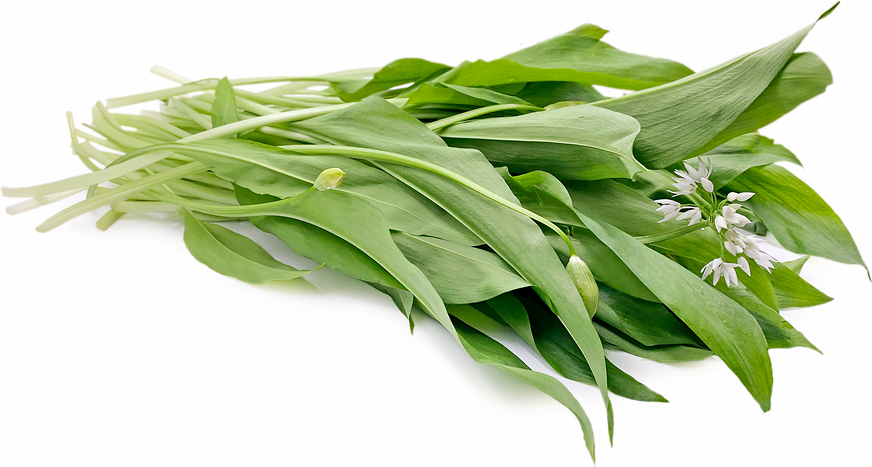


Wild Garlic
Estimated Inventory, lb : 0
This item was last sold on : 12/06/24
Description/Taste
Wild garlic has long, lanceolate leaves that can grow up to twenty-five centimeters in length and seven centimeters in diameter. The bright green leaves are smooth, flat, and glossy with one prominent, central vein, and are connected to flexible, pale green stems. The leafy plant also bears many small, white flowers that grow in a globe-like formation and have six slender, pointed petals. Wild garlic is highly fragrant with a pungent, garlic and onion-like aroma, and this scent is heightened when the leaves are crushed. When utilized in culinary applications, the leaves and flowers contain a fresh, green, mild garlic flavor that is less potent than dried garlic bulbs.
Seasons/Availability
Wild garlic is available in the mid-winter through late spring in Europe and Asia.
Current Facts
Wild garlic, botanically classified as Allium ursinum, is a leafy perennial herb growing up to forty centimeters in height and is a member of the Amaryllidaceae family. Also known as Ramsons, Bear’s garlic, Gypsy’s onions, Wood garlic, Broad-leaved garlic, and Buckrams, Wild garlic grows in damp forests, often along rivers and streams and is commonly foraged from the wild as a specialty culinary item. It is important to note that Wild garlic is similar in appearance to lily of the valley, a toxic plant, so research and care should be taken if harvesting from the wild. Favored for its mild garlic taste, Wild garlic is used as an aromatic in a wide variety of culinary applications and is especially popular in Europe as a seasonal, spring flavoring.
Nutritional Value
Wild garlic contains copper, vitamins A and C, phosphorus, iron, and calcium.
Applications
Wild garlic can be consumed both raw or cooked, and all parts of the plant including the flowers, leaves, and stems are edible. When raw, the leaves can be thinly sliced and added to salads, topped over mashed potatoes, blended into pesto, sprinkled over pizza, or chopped and mixed into sour cream, mayonnaise, cottage cheese, and cream cheese. The leaves and flowers can also be lightly cooked and incorporated into stews, soups, pancakes, muffins, or pasta. Wild garlic pairs well with meats such as lamb, beef, poultry, or fish, asparagus, peas, parsley, mushrooms, potatoes, and beans. The leaves will keep up to one week when trimmed, placed in a glass of water, and stored in the refrigerator.
Ethnic/Cultural Info
One of the unique uses of Wild garlic was in 19th century Switzerland where farmers would feed their cattle with the green leaves. This pungent diet would cause the cow’s milk to be slightly flavored and was used to make a garlic-flavored cheese. These cheeses using Wild garlic are still popular today and have seen a recent demand increase in Germany with supermarkets and retailers now offering Wild garlic. Consumers are searching for the mild greens in order to create subtle garlic-flavored dishes and are infusing the greens in pasta, pesto, sausages, and bread. There is even an annual fair held in March and April in Eberbach, Germany to celebrate the aromatic plant.
Geography/History
Wild garlic is native to Europe and Asia and has been growing wild since ancient times. Found in moist forests and woodlands, Wild garlic is still foraged from the wild today and can be found at farmers markets and specialty grocers in Asia and Europe including England, Scotland, Germany, Switzerland, and Finland.
Recipe Ideas
Recipes that include Wild Garlic. One












